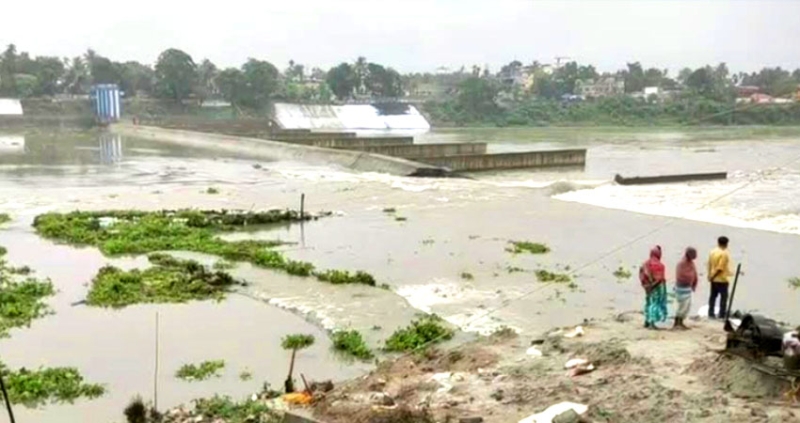- Body of Osman Hadi Returns to Dhaka From Singapore Late |
- Fakhrul condemns attacks on media, calls for unity, justice |
- 2 cops among 4 hurt in clash outside Indian Assit H.C. in Ctg |
- Inqilab Moncho urges people to avoid violence |
- Hadi’s death: Prothom Alo, Daily Star offices set afire |
Flood Fears Rise as Atrai River Dam Collapses Again

Concerns over widespread flooding have intensified after the controversial dam on the Indian side of the Atrai River collapsed once again on Tuesday morning, just four months after its initial breach in February.
The dam, constructed last year at a cost of around Tk 30 crore, gave way under pressure from rising water levels triggered by persistent monsoon rains. The sudden collapse has alarmed residents on both sides of the border, particularly in Bangladesh’s Rajshahi and Naogaon districts, where the river re-enters from India and flows downstream through densely populated and agriculturally vital areas.
The Atrai River, originating in Bangladesh, briefly meanders into India before rejoining Bangladeshi territory—a transboundary course that makes any disruption in its flow or infrastructure a matter of bilateral concern.
The latest breach occurred near Jarosore in India’s South Dinajpur district, where partial repair work had been carried out following flood damage earlier this year. The renewed collapse has not only raised fears of inundation but also sparked political controversy in India, where opposition leaders are blaming shoddy construction and corruption for the dam’s failure.
Sukanta Majumdar, a Member of Parliament from South Dinajpur and a central minister, visited the site and lashed out at local authorities, alleging misappropriation of public funds. “They used TMT rods meant for residential construction. This is criminal negligence and blatant misuse of taxpayer money,” he said, demanding a high-level inquiry into the matter.
In response, Balurghat Municipality Chairman Ashok Mitra called the accusations baseless and politically motivated. “This was a natural calamity, not a man-made disaster. The BJP should look inward before pointing fingers,” he countered, citing alleged irregularities in other high-profile infrastructure projects, including the Ram Temple construction.
Meanwhile, in Bangladesh, officials from the Water Development Board (BWDB) expressed deep concern over the potential for cross-border flooding. “This is not just an Indian matter. The flow of the Atrai directly affects our agricultural lands, biodiversity, and communities. A failure upstream can cause devastation downstream,” said one BWDB official, requesting anonymity.
Rising water levels in the Atrai have already been recorded in several areas of Naogaon and Rajshahi, prompting authorities to step up monitoring and issue early warnings in low-lying villages. Farmers in these regions fear the destruction of newly planted crops, while residents worry about the structural integrity of embankments and the potential for displacement.
Despite the looming danger, no formal assurance or action plan has yet been announced by the Indian or Bangladeshi administrations. This lack of response has intensified frustration among local communities, who are demanding immediate repairs, flood mitigation measures, and compensation in case of damage.
As monsoon intensifies in the coming weeks, the situation remains precarious. The collapse of the Atrai dam underscores the urgent need for better regional water governance, cross-border collaboration, and accountability in infrastructure development.

